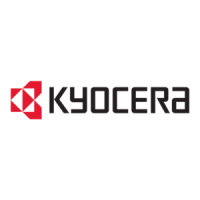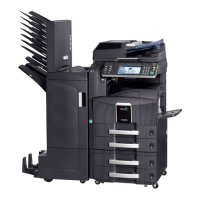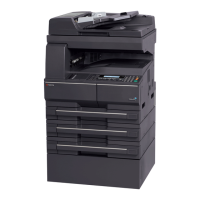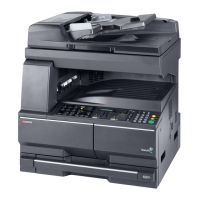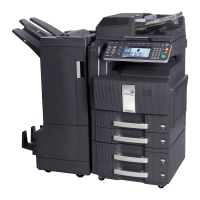Do you have a question about the Kyocera TASKalfa 4012i and is the answer not in the manual?
Details safety warnings, symbols, and their meanings to ensure correct and safe usage of the machine.
Provides cautions for handling consumables like toner and other precautions for machine usage and storage.
Explains laser radiation hazards and the machine's classification as a Class 1 laser product under IEC/EN 60825-1.
Declares compliance with EU directive and FCC rules, detailing RF exposure limits and interference guidelines.
Outlines the limited warranty terms, coverage period, exclusions, and customer rights for products sold in the US and Canada.
Warns about potential security risks like data interception and unauthorized access in unsecured wireless LAN environments.
States prohibitions on copying the guide and lists registered trademarks, software licenses, and product names.
Identifies and labels the external parts of the machine, including the document processor, cassettes, and operation panel.
Identifies and labels the internal connectors and ports, such as USB, network interfaces, and option slots.
Illustrates and labels external parts with optional equipment like paper feeders and finishers attached.
Explains how to connect the machine to PCs or tablets via USB, LAN, Wi-Fi, or Wi-Fi Direct.
Describes the procedure for turning the machine's power switch on and off, including safety precautions.
Identifies and describes the functions of various keys on the operation panel and the touch panel.
Explains the display of the Home screen and how to customize its icons and background.
Explains how to log in using the login user name and password, covering normal login and alternative methods like ID card login.
Guides on setting the local date, time, and time difference from GMT, crucial for features like email transmission.
Explains how to configure wired network settings, including TCP/IP (IPv4) for connecting to Windows networks.
Details how to configure wireless network settings using the Wi-Fi Setup Tool or by directly connecting via Wi-Fi Direct.
Explains Low Power Mode and Sleep Mode for reducing power consumption, including recovery times and the function of the Energy Saver indicator.
Guides on configuring FAX, network, and Energy Saver settings through a wizard-style interface.
Explains how to install necessary software from the DVD for PC printing, scanning, and network fax functions.
Guides on registering the machine to the TWAIN Driver for scanning documents using compatible application software.
Explains how to register the machine to the WIA Driver for scanning documents using Windows imaging acquisition.
Provides essential preparations for administrators, including sending documents to a PC and implementing security measures.
Explains how to access Command Center RX via a web browser to configure various machine settings, including security and network parameters.
Guides on handling paper before loading, including precautions for paper condition and selecting feeder units.
Mentions paper stopper and envelope stack guide adjustments for proper paper output.
Guides on checking information and creating a shared folder on a computer for receiving documents.
Explains how to save destination information for sending documents via E-mail, Folder, or Fax, enabling efficient addressing.
Explains how to configure various print-related settings through the printer driver properties screen.
Details how to change default printer driver settings for frequently used options to simplify printing.
Provides methods for printing from a PC using the KX DRIVER, covering standard and non-standard paper sizes.
Explains printing jobs from handheld devices or computers without a printer driver, supporting AirPrint, Google Cloud Print, and Mopria.
Details how Wi-Fi Direct enables direct device communication without an access point for printing.
Explains configuring the network between the machine and handheld device via NFC tag tapping for printing.
Guides on saving print jobs into the Job Box for later printing as necessary.
Describes the Status Monitor for monitoring printer status and providing ongoing reporting.
Explains how to load originals onto the platen or document processor based on size, type, volume, and function.
Guides on loading paper, envelopes, and cardstock into the multipurpose tray, including capacity and special paper handling.
Explains registering frequently used functions as a single program for quick recall by pressing a program number.
Explains expanding machine functionality by installing applications for tasks like scanning or authentication.
Explains registering shortcuts in the Quick Setup screen for easy access to frequently used functions and settings.
Covers basic copy operations, including placing originals, previewing, selecting functions, and entering copy quantity.
Explains sending scanned images via E-mail, shared folders (SMB/FTP), or TWAIN/WIA applications.
Introduces useful scanning methods like WSD Scan, DSM Scan, File Management Utility, and Multi Sending.
Explains sending a document to multiple destinations like E-mail, folders, and fax numbers simultaneously.
Describes sending documents from a custom box to the logged-in user's E-mail address when user login is enabled.
Guides on canceling sending jobs that are being scanned or are in progress.
Explains selecting and confirming destinations for sending, including choosing from Address Book, One Touch Key, Speed Dial, or FAX.
Explains using the FAX function, noting the requirement for an optional FAX Kit.
Introduces Document Box functions for saving and sharing print data, including Custom Box, Job Box, Removable Memory, and Fax Box.
Explains Repeat Copy Box and Form for Form Overlay Box, referring to other sections for Private Print/Stored Job and Quick Copy boxes.
Guides on using USB memory directly for printing files or storing scanned images.
Explains using the Internet browser on the touch panel when the machine is network-connected.
Explains stapling copied paper manually without a print operation, useful for forgotten settings or stapling originals.
States that the machine offers various functions and guides on selecting them via tabs and function keys.
Details functions related to copying, including original size, paper selection, mixed size originals, orientation, collate/offset, staple/punch, and paper output.
Lists and describes various functions categorized by tab, such as Image Quality, Layout/Edit, and Advanced Setup.
Details settings for sending functions, including original size, file format, and sending size.
Configures settings for paper selection and duplex printing when printing from the removable memory.
Explains checking the status of jobs being processed or waiting to be printed, covering Printing, Sending, Storing, and Scheduled jobs.
Explains checking job histories displayed in four screens: Printing Jobs, Sending Jobs, Storing Jobs, and FAX Jobs.
Covers procedures for pausing, resuming, canceling jobs, and priority override for waiting jobs.
Explains configuring devices/lines and checking their status, including scanner, printer, FAX, removable memory, and hard disk.
Guides on checking toner and paper levels on the touch panel, including toner information and paper status.
Explains configuring settings related to overall machine operation, covering operation method and system menu settings.
Covers common settings for machine operation, including Language, Default Screen, Sound, Keyboard Layout, and Original/Paper Settings.
Explains configuring Home screen settings, including customizing desktop, taskbar, and wallpaper.
Covers copy function settings like paper selection, auto image rotation, auto paper selection, and preset limits.
Details settings for sending functions, including Quick Setup Registration, destination check, color type, and default screen.
Explains settings for Custom Box, Job Box, Sub Address Box, and Polling Box.
Guides on configuring fax functions, referring to the FAX Operation Guide.
Explains settings for printing from computers, including emulation types and printer driver default configurations.
Guides on printing reports to check machine settings, status, and history, including print reports and admin report settings.
Covers machine system settings, including network setup, optional network, primary network, security level, interface block, data security, Bluetooth, restart, and NFC.
Covers configuration of Address Book, One Touch Key, and Print List settings, as well as address book defaults and edit restrictions.
Explains settings related to machine management, covering user login, job accounting, user property, date/timer/energy saver, adjustment/maintenance, internet, and application settings.
Details date, time, and energy saver settings, including time zone, auto panel reset, sleep modes, and timers.
Covers procedures for adjusting printing quality and conducting machine maintenance, including tone curve adjustment and drum refresh.
Guides on configuring internet settings, including using the Internet browser.
Explains configuring settings for applications installed on the machine.
Explains how user access is administered on the machine, covering security levels like User, Administrator, and Machine Administrator.
Guides on enabling user login administration and selecting authentication methods like Local or Network Authentication.
Covers user registration, alteration, deletion, and configuration of user login settings, including authentication security and lockout.
Explains how job accounting manages counts by assigning IDs to accounts, covering printing, scanning, and FAX job management.
Guides on enabling job accounting and configuring associated settings.
Covers adding, changing, and deleting accounts, and setting usage restrictions for each account.
Guides on setting default values for usage limits and enabling paper size counting, covering default settings, page counts, and accounting reports.
Explains procedures for login/logout, applying limits, managing copy/printer counts, and unknown user settings when job accounting is enabled.
Explains essential cleaning procedures for glass platen, document processor, and slit glass to maintain optimal printing quality.
Offers general guidelines for solving common problems, including checkpoints and corrective actions for various machine operation and image issues.
Covers procedures for adjusting printing quality and conducting machine maintenance, including tone curve adjustment and drum refresh.
Provides detailed instructions and illustrations for clearing paper jams from various locations, including cassettes, trays, duplex unit, and finishers.
Provides instructions for clearing staple jams in the 1,000-Sheet Finisher and the 3,000-Sheet Finisher.
Lists and illustrates the optional equipment available for the machine, such as document processors, finishers, and interface kits.
Describes how to enter characters using the on-display keyboard on the touch panel, covering lower-case, upper-case, and symbol entry.
Explains paper sizes and types that can be used in the paper source, covering basic specifications, supported paper, and special paper considerations.
Lists detailed specifications for the machine, including copy functions, printer functions, scanner functions, document processor, paper feeders, and finishers.
Provides definitions for technical terms and functions used in the manual, such as Accessibility, AppleTalk, Auto-IP, and Bonjour.
| Print Technology | Laser |
|---|---|
| Print Speed (Black) | 40 ppm |
| Print Resolution | 1200 x 1200 dpi |
| Duplex Printing | Yes |
| Scanner Type | Color Scanner |
| Maximum Scan Resolution | 600 x 600 dpi |
| Monthly Duty Cycle | 150, 000 pages |
| Operating System Compatibility | Windows, Mac OS, Linux |
| Connectivity | Ethernet |
| Warm-up Time | 17 seconds |
| Memory | 2 GB |
| Hard Disk Drive | Optional 320 GB HDD |
| Functions | Print, Copy, Scan, Fax |
| Fax Transmission Speed | 33.6 kbps |

